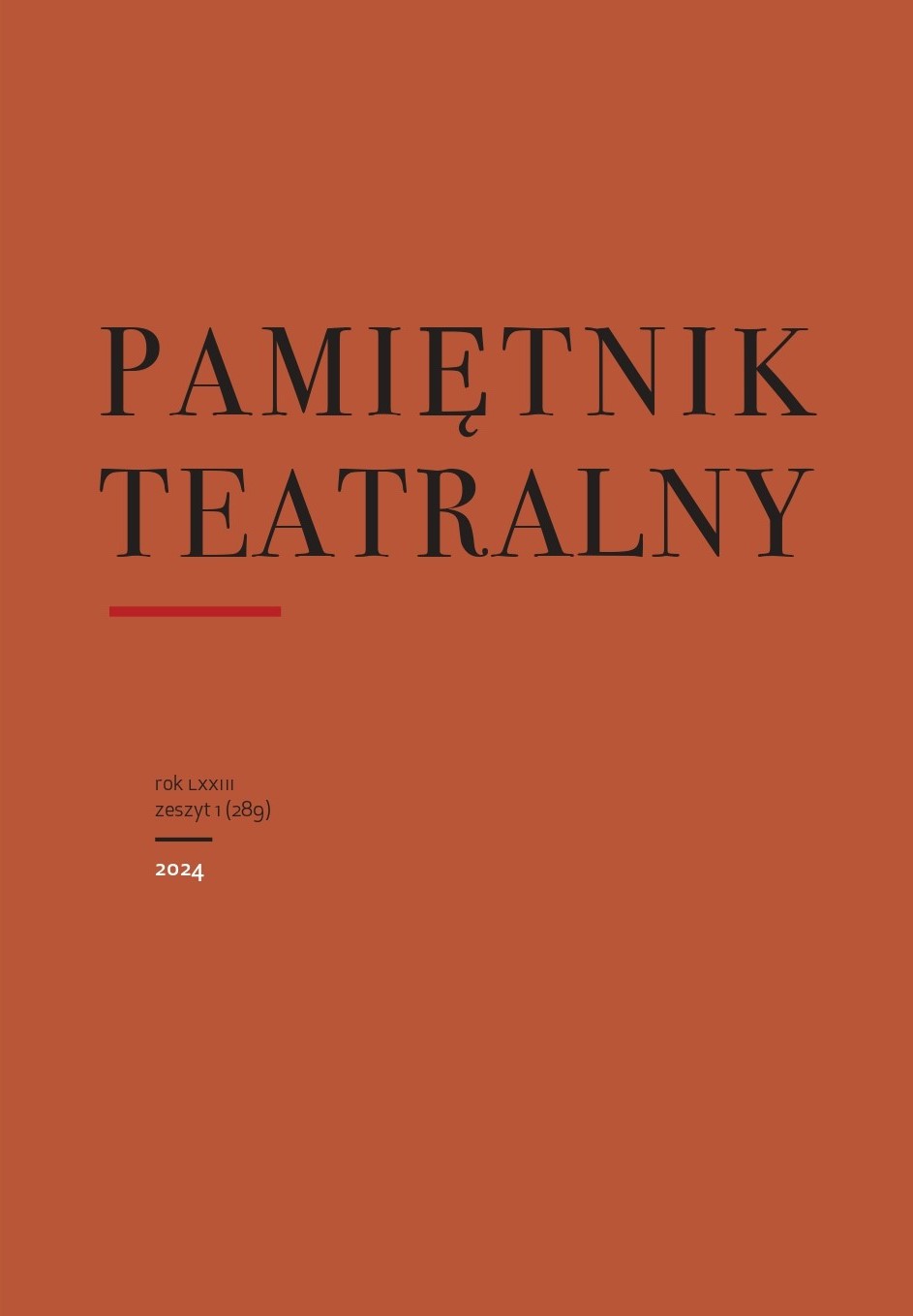On Boulevard Theatre: A Sketch
Dobrochna Ratajczakowa
The Adam Mickiewicz Univeristy in Poznań (Poland)
https://orcid.org/0000-0002-8073-4869
Abstract
The boulevard and its theatre is a phenomenon of mixed social, political, and artistic character. We can talk about at least three stages of its history. First, we have a prologue reaching back well into the 17th century and possibly even earlier, to fair theatre that has its own history as well. This is where the troupes that started taking up residence on the boulevards in the second half of the 18th century had come from. The boulevards themselves replaced the old city walls that had been torn down. This is where modern popular culture has been born, in a home to a variety of trading, entertainment, and consumption practices that welcomed a large number of private stages that, supported by the processes of democratisation, were cropping up after the Revolution abolished theatre monopolies. What emerged was a multisystem of popular attractions that developed its own culture of participation and, in its original version, referred mostly to plebeian audiences. After the Second World War, with the consecration of avant-garde, when Eurovision has been established and cinema has taken over great commercial and entertainment enterprises, boulevard theatre has become a marginal phenomenon, though it still has a loyal audience.
Keywords:
theatre history, boulevard theatre, boulevard, stage performance, theatrical production and managementReferences
Abercrombie, N., Lash, S., & Longhurst, B. (1998). Przedstawienie popularne: Przerabianie realizmu (E. Mrowczyk-Hearfield, tłum.). W: R. Nycz (red.), Odkrywanie modernizmu: Przekłady i komentarze. Kraków: Universitas.
Google Scholar
Allévy-Viala, A. (1958). Inscenizacja romantyczna we Francji (W. Natanson, tłum.). Warszawa: PIW.
Google Scholar
Bourdieu, P. (2007). Reguły sztuki: Geneza i struktura pola literackiego (A. Zawadzki, tłum.). Kraków: Universitas.
Google Scholar
Brazier, N. (1883). Chroniques des Petits Theatres de Paris (vol. 1-2). Paris: Rouveyre et G. Blond.
Google Scholar
Brzozowska, B. (2009). Spadkobiercy flaneura: Spacer jako twórczość kulturowa – współczesne reprezentacje. Łódź: Wydawnictwo Uniwersytetu Łódzkiego.
Google Scholar
Carroll, N. (2011). Filozofia sztuki masowej (M. Przylipiak, tłum.). Gdańsk: słowo/obraz terytoria.
Google Scholar
de Certeau, M. (2008). Wynaleźć codzienność: Sztuki działania (K. Thiel-Jańczuk, tłum.). Kraków: Wydawnictwo Uniwersytetu Jagiellońskiego.
Google Scholar
Corvin, M. (2001). Dictionnaire encyclopédique du théâtre (vol. 1-2). Paris: Bordas editions.
Google Scholar
de Jomaron-Leyvastre, J. (ed.). (1989). Le theatre en France: Du Moyen Age a nos jours (A. Mnouchkine, preface). Paris: Armand Colin.
Google Scholar
Descotes, M. (1955). Le drame romantique et ses grands créateurs (1827–1839). Paris: Presses universitaires de France.
Google Scholar
Descotes, M. (1964). Le public de théâtre et son histoire. Paris: Presses universitaires de France.
Google Scholar
Duvignaud, J. (1965). L'acteur: Esquisse d'une sociologie du comedien. Paris: Gallimard.
Google Scholar
Gascar, P. (1980). Le Boulevard du Crime. Paris: Hachette-Massin.
Google Scholar
Gengembre, G. (1999). Le théâtre français au XIX siècle. Paris: Armand Colin.
Google Scholar
Ginisty, P. (1910). Melodrame. Paris: Louis-Michaud.
Google Scholar
Jakóbczyk, S. (2005). Na Zachód ze Wschodu: Savoir i Kessel w nowoczesnym przemyśle literackim, Poznań: Wydawnictwo Naukowe UAM.
Google Scholar
Krakovitch, O. (1987). Robert Macaire ou la grande peur des censeurs. Europe, 703–704.
Google Scholar
Naugrette-Christophe, C. (1998). Paris sous le Second Empire, le théâtre et la ville: essai de topographie théâtrale. Paris: Paris Librairie Théâtrale.
Google Scholar
Omilanowska, M. (2004). Świątynie handlu: Warszawska architektura komercyjna doby wielkomiejskiej. Warszawa: Instytut Sztuki Polskiej Akademii Nauk.
Google Scholar
Ratajczakowa, D. (2006). Bajka o winie i wodzie: Kilka uwag o muzyce, dramacie i teatrze. W: W krysztale i w płomieniu: Studia i szkice o dramacie i teatrze (t. 1). Wrocław: Wydawnictwo Uniwersytetu Wrocławskiego.
Google Scholar
Surer, P. (1973). Współczesny teatr francuski: Inscenizatorzy i dramatopisarze (K.A. Jeżewski, tłum.). Warszawa: PIW.
Google Scholar
Švehla, J. (1983). Deburau: pierrot nieśmiertelny (M. Erhardt-Gronowska, tłum.). Warszawa: PIW.
Google Scholar
Temkine, R. (1967). L’éntreprise théâtre. Paris: Éditions Cujas.
Google Scholar
Terni, J. (2013). Teatr początków kultury masowej: Francuski wodewil i miasto 1830–1848 (P. Morawski, tłum.). Dialog, 1.
Google Scholar
Ubersfeld, A. (1993). Le drame romantique, Paris: Belin.
Google Scholar
Vessillier, M. (1973). La crise du théâtre privé. Paris: Presses universitaires de France.
Google Scholar
Wałaszewski, Z. (2015). Papierowy jednorożec, klubówka i „Łowca androidów”: O powstawaniu supersystemu rozrywkowego. W: A. Gemra (red.), Literatura i kultura popularna: Badania, analizy, interpretacje. Wrocław: Uniwersytet Wrocławski.
Google Scholar
Authors
Dobrochna RatajczakowaThe Adam Mickiewicz Univeristy in Poznań Poland
https://orcid.org/0000-0002-8073-4869
Statistics
Abstract views: 583PDF downloads: 418
License
Copyright (c) 2018 Dobrochna Ratajczakowa

This work is licensed under a Creative Commons Attribution-NonCommercial-NoDerivatives 4.0 International License.
The author grants a royalty-free nonexclusive license (CC BY 4.0) to use the article in Pamiętnik Teatralny, retains full copyright, and agrees to identify the work as first having been published in Pamiętnik Teatralny should it be published or used again (download licence agreement). By submitting an article the author agrees to make it available under CC BY 4.0 license.
From issue 1/2018 to 3/2022 all articles were published under a Creative Commons license CC BY-NC-ND 4.0. During this period the authors granted a royalty-free nonexclusive license (CC BY-ND 4.0) to use their article in Pamiętnik Teatralny, retained full copyright, and agreed to identify the work as first having been published in our journal should it be published or used again.
Most read articles by the same author(s)
- Dobrochna Ratajczakowa, On Generosity: Remembering Ewa Guderian-Czaplińska (1962–2020) , Pamiętnik Teatralny: Vol. 69 No. 1 (2020)
- Dobrochna Ratajczakowa, A Confluence of Times: Theater, Performance, and Re-enactment , Pamiętnik Teatralny: Vol. 70 No. 3 (2021): Theater and Communitas (with essay-cluster curated by Dorota Sajewska)
- Dobrochna Ratajczakowa, Some Remarks on the Nature of Opera, Or, Why Did Frédéric Chopin Not Compose a National Opera , Pamiętnik Teatralny: Vol. 72 No. 2 (2023): Opera – Pop – Culture (with essay cluster curated by Katarzyna Lisiecka and Adam Regiewicz)
- Dobrochna Ratajczakowa, “The Same Place” for “Eagles and Mosquitos of the Parnassus,” or What Drama (and What Theater for That Drama) Our Enlighteners Envisioned , Pamiętnik Teatralny: Vol. 66 No. 3 (2017)









